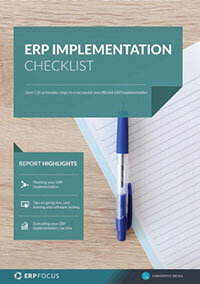The key phases of ERP implementation
So, you've decided to implement a new ERP system to digitally transform your organization. Do you have an ERP implementation plan? That sound of that phrase alone sounds daunting, as ERP implementations are notorious for their high cost, long timelines, and failure rate. Being educated on the key phases of the ERP implementation life cycle and learning their best practices can help minimize your risk of ERP failure.
What is an ERP implementation?
What is ERP implementation? Robust software suites like ERP systems are not like consumer-facing applications where a download and install is all it takes to start using the system. First, ERP software requires power-house infrastructure (whether that be cloud or on-premise servers) to host it. Your IT department will evaluate the infrastructure options and set up the foundation for the ERP software to run. Second, the application has an extremely wide breadth of capabilities. ERP systems are highly configurable, often requiring the expertise of ERP consultants to translate your business requirements to the right configuration within the software. An ERP implementation covers all these aspects (and more).
The ERP implementation life cycle
Because an ERP implementation covers so much ground, these projects are broken up into several ERP implementation phases. Every consulting firm, ERP vendor and project management team will run these implementations differently, but there are a few ERP implementation phases that are common across the industry.
Check out our seven-step ERP implementation methodology for a full guide on implementing your system
Initiation
This ERP implementation phase is self-explanatory. At the very beginning of the ERP implementation life cycle, the initiation phase should take place. It's easy to underestimate the importance of this phase, but the initiation period is essential to ERP implementation success. During this phase expectations are set, the scope is conveyed, and key players are introduced.
Scope definition and expectation setting are critical for a successful ERP implementation as these activities lay the foundation for the following phases. If your team doesn't have a solid grasp on what processes are in and out of scope, this could lead to scope creep and time spent on frivolous requirements. Introduction of key players within the project team and reviewing the RACI matrix will establish the groundwork of how the team should work together. This phase should include an official kick-off to introduce the project to the entire organization and gain their support and excitement.
Requirements gathering and analysis
The requirements gathering and analysis phase is another ground laying essential. Without quality requirements and defined business processes, configuring the ERP software is almost impossible. During this phase of the ERP implementation life cycle, requirements workshops should be held. The outcome of these workshops should be SMART (specific, measurable, attainable, relevant, and time-constrained) requirements that the team can further analyze. Requirements gathering can be tedious, but luckily there are many tips on how to be successful at it.
Once quality requirements are documented, a fit and gap analysis will be performed to determine if the ERP software can meet the requirements (a fit) or require a customization (a gap). For the fit requirements, the ERP software should be configured appropriately and demoed to the business for approval. Even if a requirement is marked as a fit, business users may see the system in action and realize it doesn't quite meet their requirements. This "ah-ha" moment leads to further refinement of existing requirements.
Design
For those requirements gathered in the previous phase that were marked as gaps, the development team (alongside the functional team) will evaluate the effort and complexity to develop a solution. If project leadership approves the gap for development, a design will be drafted to meet the requirement and it is presented to the business for feedback. If the business approves, the design is then turned into a design document and sent over to the development team for the next phase.
Build
The build phase can be further broken down into three sub-phases: develop, deploy, test. Like any software implementation project, new code will be developed, deploying into a testing environment and then thoroughly tested by ERP consultants and business analysts. The build phase along with the requirements gathering and analysis and design phases can be run in an agile fashion, depending on what was decided for the ERP implementation project plan. Traditionally, ERP implementations were managed using a waterfall approach, but current trends in ERP implementation methodology are finding that implementers are finding their own best way to manage the project plan.
User acceptance testing
Separate from the testing for new code in the build phase, user acceptance testing is another round of testing for business users to see entire processes in action. Any last-minute bugs are found and addressed, and integrations to the ERP system are turned on and tested end-to-end. This is also the phase where end-user training begins.
It's during this phase that business users give their final stamp of approval before making a go/no go decision.
Go-live
Arguably the most exciting phase in an ERP implementation is the go-live phase. While there is excitement there is also the risk of not sticking to your ERP implementation project plan. Go live entails way more than flipping the "on switch". It involves executing a cutover task list to migrate legacy data into production, readying your production environment and scheduling your team for overtime and late nights.
Avoid hidden costs during your ERP project using our free guide
Communication is essential during go live. This is where members of your organizational change management team can truly shine. Communication to the business about how and when users can access the new system must be clear, strategic and readily available. The contact info for your support team (more about that in the next phase) should also be easy to find.
Hyper care
An extremely important ERP post-implementation phase is the hyper care phase. During this period, organizations will ramp up their support team training and coverage to ensure any production issues are squashed immediately. This aids in user adoption and helps the transition from the legacy system to the newly implemented ERP system remain smooth.
ERP implementation best practices
Now that you're familiar with the key phases of ERP implementation, here are some best practices to have a successful ERP implementation:
- Don't underestimate pre and post ERP implementation phases (like initiation and hyper care)
- Be strict about requirements quality, ensure they are SMART
- Create end-user documentation as you go (you're likely writing these steps down already)
- Test, test, and test again – solicit a variety of scenarios for all your test cases from a diverse business pool
Free white paper

ERP Implementation Checklist
Over 120 actionable steps to implementing a new ERP successfully



